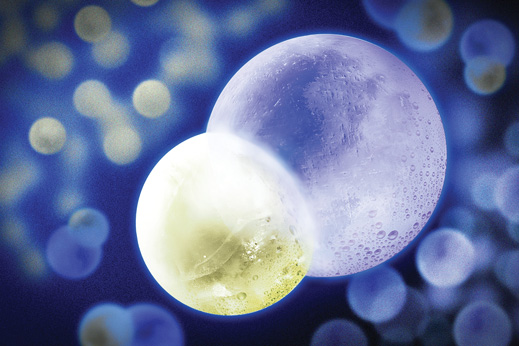The air around us is a chaotic superhighway of molecules colliding with each other at a thousand miles per hour. Such erratic molecular behavior is normal at ambient temperatures.

Scientists have long suspected that if temperatures were to plunge to near absolute zero, molecules would come to a halt, ceasing their individual motion and behaving as one collective body. This more orderly molecular behavior would result in exotic states of matter never observed in the physical world.
Now MIT physicists have successfully cooled a gas of sodium potassium molecules to a temperature of 500 nanokelvins—just a hair above absolute zero, and less than a millionth the temperature of interstellar space. The ultracold molecules, which moved at average speeds of centimeters per second, were relatively long-lived and stable, resisting reactive collisions (those that cause them to break apart). The molecules’ vibrations and rotations were also effectively stilled.
As a first step in creating ultracold molecules, the team used lasers and evaporative cooling to chill clouds of individual sodium and potassium atoms to near absolute zero. Then they essentially glued the atoms together, applying a magnetic field to prompt them to bond—a mechanism known as a “Feshbach resonance,” named after the late MIT physicist Herman Feshbach.
The resulting bond is relatively weak. To bring the atoms closer together to create a stronger, more stable molecule, the team employed a technique first reported by others in 2008.
For this technique, the newly created molecules were exposed to a pair of lasers operating at different frequencies; the difference between those frequencies exactly matched the energy difference between the molecule’s initial, highly vibrating state and its lowest possible vibrational state.
With this method, the group brought the molecules down to their lowest vibrational and rotational states—a huge drop in energy.
“In terms of temperature, we sucked away 7,500 kelvins, just like that,” says Martin Zwierlein, a professor of physics at MIT and a principal investigator in MIT’s Research Laboratory of Electronics.
Before we can begin to see exotic states of matter, Zwierlein says, molecules will have to be cooled to all but freeze them in place: “Now we’re at 500 nanokelvins, which is already fantastic—we love it. Just another factor of 10 or so colder, and the music starts playing.”
Keep Reading
Most Popular
Large language models can do jaw-dropping things. But nobody knows exactly why.
And that's a problem. Figuring it out is one of the biggest scientific puzzles of our time and a crucial step towards controlling more powerful future models.
The problem with plug-in hybrids? Their drivers.
Plug-in hybrids are often sold as a transition to EVs, but new data from Europe shows we’re still underestimating the emissions they produce.
Google DeepMind’s new generative model makes Super Mario–like games from scratch
Genie learns how to control games by watching hours and hours of video. It could help train next-gen robots too.
How scientists traced a mysterious covid case back to six toilets
When wastewater surveillance turns into a hunt for a single infected individual, the ethics get tricky.
Stay connected
Get the latest updates from
MIT Technology Review
Discover special offers, top stories, upcoming events, and more.